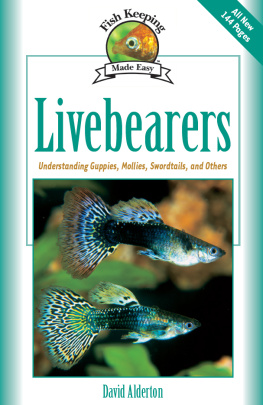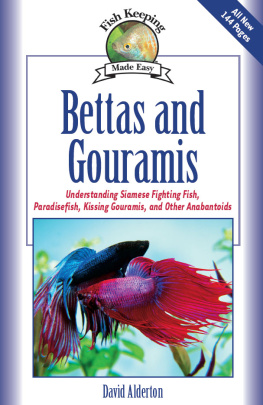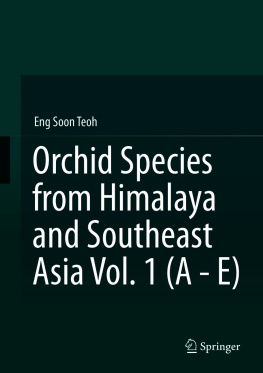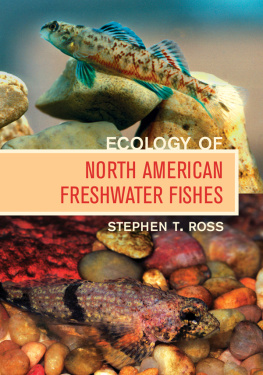

Published in 2004 by I-5 Press
A Division of I-5 Publishing, LLC
3 Burroughs, Irvine, CA 92618
www.facebook.com/i5press
www.i5publishing.com
Fish Keeping Made Easy is an imprint of I-5 Press
Produced by Andromeda Oxford Limited
Kimber House
1 Kimber Road
Abingdon
Oxon OX14 1SG.
www.andromeda.co.uk
Copyright Andromeda Oxford Limited 2004
Cover design copyright by I-5 Press
All rights reserved. No part of this book may be reproduced, stored in a retrieval system, or transmitted in any form or by any means, electronic, mechanical, photocopying, recording, or otherwise, without the prior written permission of the copyright holder, except for the inclusion of brief quotations in an acknowledged review.
Project Director: Graham Bateman. Managing Editor: Shaun Barrington.
Editing and design: D & N DTP and Editorial Services.
Cartography: Tim Williams. Indexer: Sheila Seacroft
Picture Manager: Claire Turner. Production: Clive Sparling.
Library of Congress Cataloging-in-Publication Data
Alderton, David, 1956
Livebearers / by David Alderton.
p. cm. -- (Fishkeeping made easy)
Includes bibliographical references (p. ) and index.
ISBN 1-931993-19-X (hardcover : alk. paper)
eISBN 978-1-62008-006-1
1. Livebearing aquarium fishes. I. Title. II. Series.
SF458.L58A58 2003
639.3'7667--dc21
2003013120
Page 2: Merry widow (Phallichthys amates amates).
Cover: Tuxedo multi-color snakeskin guppy, (Poecilia reticulata var.); Max Gibbs/Photomax.
Photographic credits
Andromeda Oxford Limited 71 x4, 85; Dennis Barrett 35, 40, 42; John Dawes 22; www.Hippocampus-Bildarchiv.de 2, 9b, 1011, 1213, 13, 14, 16, 17, 1819, 23, 2425, 26, 27, 28t, 28b, 29, 30t, 30b, 31, 32, 33, 34, 36t, 36b, 37, 41, 43, 44, 45, 46, 47, 50, 51t, 51b, 52, 53, 5455, 55t, 55b, 57, 75, 82, 87, 96, 107, 109, 110, 120, 121, 124, 125, 127, 128, 129, 130, 131, 132, 133, 134, 135, 137; D. Lambert 122; Aldo Brando/Oxford Scientific Films 9c; Peter Gathercole/Oxford Scientific Films 99; Max Gibbs/Photomax 3, 7, 15, 21, 38, 39, 48, 49, 56, 6061, 6667, 68, 73, 7475t, 7475b, 77, 78, 81, 83, 92, 100, 103, 117, 119, 123, 126, 136; Mike Sandford 88, 91, 112, 115, 118; Jane Burton/Warren Photographic 84, 90, 98, 104, 106, 114.
Color origination by Grasmere Digital Imaging Ltd., Leeds.
Printed in Hong Kong by Paramount Printing Ltd.
Contents
Nature and Nurture
The group of fish known as livebearers features some of the most attractive and fascinating species now gracing aquariums throughout the world. Their popularity today would have no doubt surprised and delighted those who are credited with discovering them in the wild and bringing them to the attention of zoologists.
IN THE BEGINNING
Tropical fishkeeping as a hobby did not really start in earnest until the early 20th century, and in the beginning it was a perilous pursuit. Tanks were designed with slate bases and heated by gas, relying on a naked flame for this purpose. This meant that accurate temperature control of the water was impossible, and dramatic and sometimes fatal fluctuations occurred. Livebearers as a group are, however, much better suited than many fish to adapting to this type of variable environment because it is not dissimilar to the conditions under which a number of species live in the wild. Livebearers often inhabit shallow stretches of water, which can be heated up rapidly by the sun, so they may be subjected to marked variations in water temperature. They are also quite adaptable in terms of their water chemistry needs.
It was as a result of their tolerance that livebearers soon became popular. Yet there was also another, more fundamental reason, why they became prominent during the early days of the aquarium hobby and have retained their preeminent position. At the outset, there were none of the special diets that are available to fish keepers today, and this meant that rearing the young of egg-laying fish could be especially problematic. In the case of the commonly kept livebearers, however, they needed relatively little care. While eggs could be afflicted by fungus, there was no risk of this problem with livebearers. And as they are relatively large at birth the fry themselves were quite easy to rear. They matured rapidly and would in turn breed repeatedly, without requiring the conditioning triggers that prove necessary in the case of egg-layers.
FAMOUS FIND
The Reverend John Guppy recorded the wild form of what has since become the best known of all livebearers, and now bears his name, on the Caribbean island of Trinidad just off the northern coast of South America around 1865. He subsequently brought live specimens back to Britain. Ironically, however, in this particular case these fish had previously been recorded two years earlier, by a Spaniard called De Filippi, whose discovery of them is now largely forgotten.

Tropical fish keeping brings the beauty of the natural world into millions of homes worldwide. Throughout this book, insights into natural fish behavior are emphasized. Understanding how a fish lives in the wild leads to a better understanding of how it should be looked after in captivity. In this case, nurture follows nature.
DEVELOPMENT OF THE HOBBY
It was not until after the end of World War II in 1945 that tropical fishkeeping entered a new era. Florida became the main center for breeding such fish on a commercial scale, thanks partly to its climate and also its geographical positionclose to Central and South America, where desirable fish, including livebearers, could be obtained. The market expanded as ex-combat pilots returned home and began to fly regular shipments from Floridas growing number of tropical fish farms to other states in the U.S. and up to Canada.
Aquarium-keeping started to develop on an unprecedented scale as a result, and the popular livebearerssuch as guppies, swordtails, mollies, and platieswere ideal to meet this demand. Breeders started to create more colorful fish, and this led to the establishment of shows; these still take place regularly in Florida, and allow breeders to display the newest variants. It is not just the color of the fish that has been modifiedfin shapes and body types have been altered too. In a number of cases, the close relationships between the different species of livebearers has led to hybridization as well, which has accelerated the process of creating new forms of these fish, far brighter and more varied in appearance than their ancestors.
Todays domesticated bloodlines of the most popular species are far removed from the wild forms, and yet livebearers as a group also offer considerable appeal to the specialist breeder who is interested in keeping and studying fish about which little is known. This applies particularly in the case of the halfbeaks, which belong to the family Hemirhamphidae. So whether you are just starting out with an aquarium or are a longstanding enthusiast, livebearers will be of interest, particularly as a number of species can also be included in a community aquarium alongside other fish.
CHAPTER 1 | Where in the World? |















